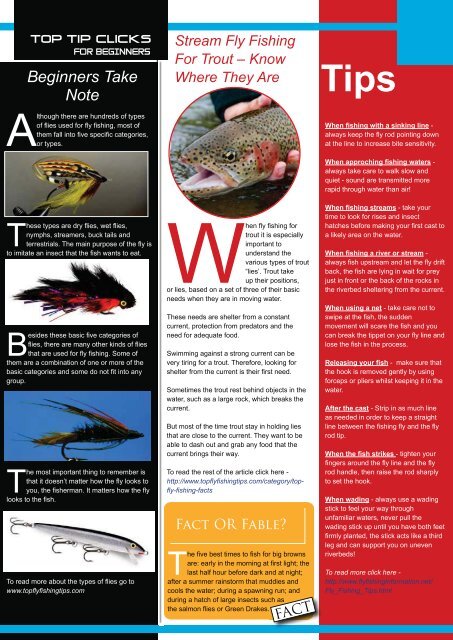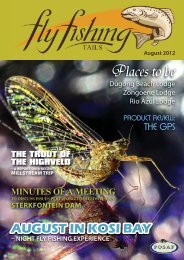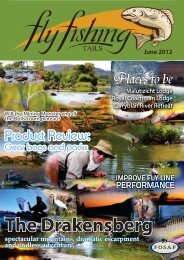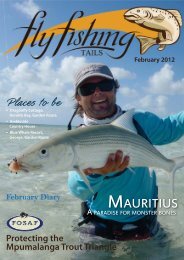Know Your Knots - Flyfishingtails
Know Your Knots - Flyfishingtails
Know Your Knots - Flyfishingtails
You also want an ePaper? Increase the reach of your titles
YUMPU automatically turns print PDFs into web optimized ePapers that Google loves.
FOR BEGINNERS<br />
Beginners Take<br />
Note<br />
Although there are hundreds of types<br />
of flies used for fly fishing, most of<br />
them fall into five specific categories,<br />
or types.<br />
These types are dry flies, wet flies,<br />
nymphs, streamers, buck tails and<br />
terrestrials. The main purpose of the fly is<br />
to imitate an insect that the fish wants to eat.<br />
Besides these basic five categories of<br />
flies, there are many other kinds of flies<br />
that are used for fly fishing. Some of<br />
them are a combination of one or more of the<br />
basic categories and some do not fit into any<br />
group.<br />
The most important thing to remember is<br />
that it doesn’t matter how the fly looks to<br />
you, the fisherman. It matters how the fly<br />
looks to the fish.<br />
To read more about the types of flies go to<br />
www.topflyfishingtips.com<br />
Stream Fly Fishing<br />
For Trout – <strong>Know</strong><br />
Where They Are<br />
When fly fishing for<br />
trout it is especially<br />
important to<br />
understand the<br />
various types of trout<br />
“lies’. Trout take<br />
up their positions,<br />
or lies, based on a set of three of their basic<br />
needs when they are in moving water.<br />
These needs are shelter from a constant<br />
current, protection from predators and the<br />
need for adequate food.<br />
Swimming against a strong current can be<br />
very tiring for a trout. Therefore, looking for<br />
shelter from the current is their first need.<br />
Sometimes the trout rest behind objects in the<br />
water, such as a large rock, which breaks the<br />
current.<br />
But most of the time trout stay in holding lies<br />
that are close to the current. They want to be<br />
able to dash out and grab any food that the<br />
current brings their way.<br />
To read the rest of the article click here -<br />
http://www.topflyfishingtips.com/category/topfly-fishing-facts<br />
Fact OR Fable?<br />
The five best times to fish for big browns<br />
are: early in the morning at first light; the<br />
last half hour before dark and at night;<br />
after a summer rainstorm that muddies and<br />
cools the water; during a spawning run; and<br />
during a hatch of large insects such ch as<br />
the salmon flies or Green Drakes.<br />
FACT<br />
Tips<br />
When fishing with a sinking line -<br />
always keep the fly rod pointing down<br />
at the line to increase bite sensitivity.<br />
When approching fishing waters -<br />
always take care to walk slow and<br />
quiet - sound are transmitted more<br />
rapid through water than air!<br />
When fishing streams - take your<br />
time to look for rises and insect<br />
hatches before making your first cast to<br />
a likely area on the water.<br />
When fishing a river or stream -<br />
always fish upstream and let the fly drift<br />
back, the fish are lying in wait for prey<br />
just in front or the back of the rocks in<br />
the riverbed sheltering from the current.<br />
When using a net - take care not to<br />
swipe at the fish, the sudden<br />
movement will scare the fish and you<br />
can break the tippet on your fly line and<br />
lose the fish in the process.<br />
Releasing your fish - make sure that<br />
the hook is removed gently by using<br />
forceps or pliers whilst keeping it in the<br />
water.<br />
After the cast - Strip in as much line<br />
as needed in order to keep a straight<br />
line between the fishing fly and the fly<br />
rod tip.<br />
When the fish strikes - tighten your<br />
fingers around the fly line and the fly<br />
rod handle, then raise the rod sharply<br />
to set the hook.<br />
When wading - always use a wading<br />
stick to feel your way through<br />
unfamiliar waters, never pull the<br />
wading stick up until you have both feet<br />
firmly planted, the stick acts like a third<br />
leg and can support you on uneven<br />
riverbeds!<br />
To read more click here -<br />
http://www.flyfishinginformation.net/<br />
Fly_Fishing_Tips.html







